The purchase of metrology equipment isn't an investment to be taken lightly, especially in tough economic times.
However, the show must go on, and parts must be measured, regardless of whether the company can afford the
equipment. Simply foregoing the measurement process would save time just as effectively as it would halt any aspirations of turning out a winning product. However, the lack of room in the
budget for metrology equipment doesn't have to hinder a company's operations or competitiveness; there's always the option of outsourcing metrology needs.
"At some point in time, every company has inspection equipment needs that are not met by in-house facilities," admits Dennis Traynor, vice president of product support
services at Mitutoyo America Corp. "At that point, contracting a qualified inspection resource is the only viable solution to qualify a manufactured part."
Determining whether your company should outsource its measurement needs is another issue. Although this article focuses specifically on outsourcing metrology
services, the same general concepts are important considerations for almost any type of outsourcing. What is outsourcing?
Simply put, outsourcing refers to hiring an outside party to perform a particular
service that your company requires. Specifically, outsourcing of metrology services typically comes in three forms:  Sending the parts. A company will send its parts to a metrology lab. The lab will
then measure the parts and return them, along with their measurements, to the company. This process can take anywhere from a few hours to a few days,
depending upon factors such as the number and complexity of the measurements, the lab's backlog and transit time. Sending the parts. A company will send its parts to a metrology lab. The lab will
then measure the parts and return them, along with their measurements, to the company. This process can take anywhere from a few hours to a few days,
depending upon factors such as the number and complexity of the measurements, the lab's backlog and transit time.
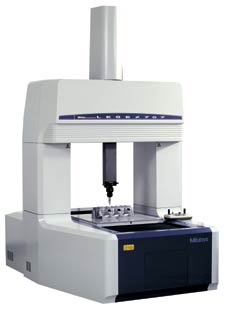
Mitutoyo America Corp.
965 Corporate Blvd.
Aurora, IL 60504
Ph: (630) 820-9666
www.mitutoyo.com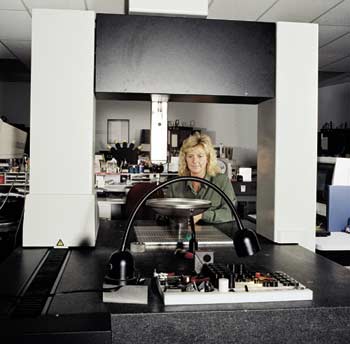
QC Inspection Services Inc.
11975 Portland Ave. S., Ste. 102
Burnsville, MN 55337
Ph: (952) 895-1150
www.qcinspect.com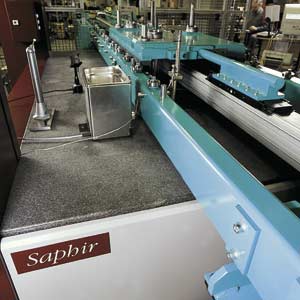
GKS Inspection Services, A Division of CEJohansson
1971 Deere Ave.
Irvine, CA 92606
Ph: (800) 346-3898
www.cejmetrology.com 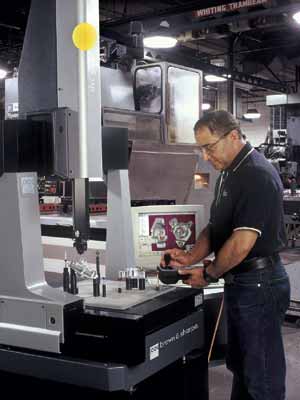 Brown & Sharpe
200 Frenchtown Road
North Kingstown, RI 02852
Ph: (401) 886-2000
www.brownandsharpe.com 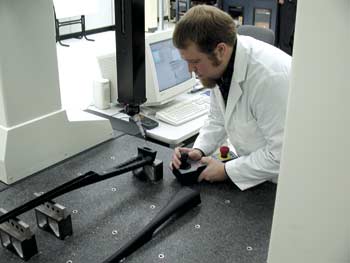
Nel PreTech Corp.
8420 W. 183rd Place
Tinley Park, IL 60477
Ph: (708) 429-4887
www.nelpretech.com |
 Bringing the measuring tool to the company. Some metrology labs
will bring measuring tools (such as portable CMMs) to their customers' facilities in instances in which sending the parts isn't feasible. "A typical scenario for this
is large-part measurement using a portable FaroArm," says Dan Medford, president of QC Inspection Services, which is a provider of metrology outsourcing services. "It can be used to measure
larger objects such as boats, small planes or tractor cabs." In these cases, however, optimum accuracy might be sacrificed. "The accuracy of our nonportable CMMs is in the
area of 0.0002 inches," says Medford. "But when using a portable CMM, we only achieve 0.033- to 0.004-inch accuracy." Bringing the measuring tool to the company. Some metrology labs
will bring measuring tools (such as portable CMMs) to their customers' facilities in instances in which sending the parts isn't feasible. "A typical scenario for this
is large-part measurement using a portable FaroArm," says Dan Medford, president of QC Inspection Services, which is a provider of metrology outsourcing services. "It can be used to measure
larger objects such as boats, small planes or tractor cabs." In these cases, however, optimum accuracy might be sacrificed. "The accuracy of our nonportable CMMs is in the
area of 0.0002 inches," says Medford. "But when using a portable CMM, we only achieve 0.033- to 0.004-inch accuracy." Outsourcing part programming. On occasions when a company that has its own metrology equipment
comes across an odd part or accepts a contract that requires measurements on parts that the company has never dealt with, it's possible to outsource just the required part programming and
perform the actual measurements in-house. Outsourcing part programming. On occasions when a company that has its own metrology equipment
comes across an odd part or accepts a contract that requires measurements on parts that the company has never dealt with, it's possible to outsource just the required part programming and
perform the actual measurements in-house.
The economics of outsourcing The best and most common
reasons to outsource metrology needs are probably economic. "In the current economy, not every company has a budget for inspection equipment," explains Traynor. "Contract inspection is a
great alternative to a short-term budget crunch." David Nelson, president of the outsourcing provider Nel PreTech Corp., shows his potential clients
overall outsourcing costs and ROI information based on their individual needs so they can see the possible economic benefits. "A recent study we did on our existing clients shows
an average cost of $1,000 per measurement project when outsourcing," he notes. "In an ROI analysis, we demonstrated that investment in competitive internal capability would only provide a
7.14-percent payback in 7.43 years—a low payback over a long period, with high risk." It's a fairly simple issue, provided the customer takes all of the economic variables into
consideration, according to Dave Genest, director of marketing and communications at Brown & Sharpe. There are two routes a company can take: buy the equipment or outsource. It's up to
the company to determine which method will cost less in the long run. The factors a company should consider include:  The cost of the measuring equipment The cost of the measuring equipment
 The cost of providing a room to house the equipment The cost of providing a room to house the equipment
 The cost of providing electricity, heat and other environmental controls to the room The cost of providing electricity, heat and other environmental controls to the room
 The cost of installing the equipment The cost of installing the equipment
 The cost of maintaining the equipment The cost of maintaining the equipment
 The cost of employing operators and part programmers The cost of employing operators and part programmers
Most companies that provide
outsourcing will calculate these costs (except for employees' pay, perhaps) and will then try to offer a lower price.
Who needs to outsource? According to Genest, those who consider outsourcing usually fall into one of four
categories. "They either think: 'I don't have the equipment, and I'd rather not buy it'; 'I don't have the equipment, but I'd like to see how it works'; 'I don't have an
operator'; or 'I've got too much work.'" Outsourcing is an obvious necessity for the first example. As for the other circumstances, outsourcing could still be the solution.  I don't have the equipment, but I'd like to see how it works. This is a "test
before you invest" sentiment. "Many companies will use outsourcing to evaluate equipment by having parts checked on the same or similar equipment to what
they're planning on buying," notes Medford. I don't have the equipment, but I'd like to see how it works. This is a "test
before you invest" sentiment. "Many companies will use outsourcing to evaluate equipment by having parts checked on the same or similar equipment to what
they're planning on buying," notes Medford.
 I don't have an operator. In such cases, a company can use outsourcing as a temporary solution to curb the cost of hiring full-time personnel during economic
slumps, when lowering employee costs is imperative.
I don't have an operator. In such cases, a company can use outsourcing as a temporary solution to curb the cost of hiring full-time personnel during economic
slumps, when lowering employee costs is imperative.
QC Inspection Services often finds that companies seek outsourcing when their
operators are out on leave. "During these times, there is a shortage of personnel, but the work still comes in," Medford explains. "Rather than implementing mandatory
overtime, many companies opt to outsource."  I've got too much work. When a company simply has too much work and not enough measurement personnel, it can outsource its overload. Likewise, if a
company finds itself with loads of work and plenty of operators but limited equipment with which to make measurements, some labs will allow parts and
operators to be sent to use their equipment. (Note that not all labs allow this type of outsourcing.)
I've got too much work. When a company simply has too much work and not enough measurement personnel, it can outsource its overload. Likewise, if a
company finds itself with loads of work and plenty of operators but limited equipment with which to make measurements, some labs will allow parts and
operators to be sent to use their equipment. (Note that not all labs allow this type of outsourcing.)
Outsourcing is also handy for those involved in short-term projects because investing in measurement equipment isn't practical when the project only lasts a few
weeks or months. When a job starts to look more permanent, companies can reevaluate their need for equipment. Leaving it to the experts
Some companies simply can't afford to hire equipment operators, can't afford to keep their current operators trained on the latest metrology developments or are
doing a short-term project that requires more expertise than their current operators have or would be cost-effective to acquire. Outsourcing provides a solution by
guaranteeing accurate measurements made by experts. "These are true metrologists," says Steve DeRemmer, a lab manager at GKS Inspection Services.
"All they focus on is taking measurements and knowing the best way to do so. Plus, they get such a variety of projects that it expands their knowledge on a daily basis."
Nel PreTech, for example, maintains its own facility, measurement equipment and staff. Customer parts are measured in an environmentally controlled lab, on accurate
equipment and by trained technicians, guaranteeing expert readings, says Nelson. Accreditation is yet another factor to consider. Outsourcing sometimes becomes a
necessity when a customer demands testing be done by accredited facilities. Companies that have entered into such a contract might consider outsourcing to labs
that can boast ISO 17025 (formerly ISO/IEC Guide 25) registration and A2LA accreditation. "By using an accredited lab, you can be assured that the service
adheres to current industry standards," says Traynor. Additionally, labs that provide metrology services tend to keep up with the latest
metrology equipment, using the newest automated measuring systems available. Cutting-edge equipment usually means faster and more accurate measurements,
which leads to faster delivery of parts to the customer. Unbiased evaluations
"Sometimes there's a disagreement between a manufacturer and the supplier relating to the function or characteristics of a part," notes Medford. "At this point, an
arbitrator, or other acting intermediary, contracts us as an accredited lab to measure the part or parts in question. Using us as a third-party inspection service, they're
assured unbiased results." DeRemmer recalls an instance when Ford Motor Co. required one of its suppliers
to use a third-party lab to have its parts inspected. GKS performed the inspections and provided the supplier with the dimensional information. Ford used the data to
perform internal engineering analysis. In this respect, GKS was being used as a research-and-development tool prior to the manufacture of components. "The
third-party company doesn't know what's good and what's bad," notes DeRemmer. "We just tell them what it really is." Disadvantages
If there are so many benefits to outsourcing metrology services, you might be wondering, "Why isn't everybody outsourcing?" Experts speculate on a number of
circumstances when outsourcing could be detrimental to a company's efficiency and budget.  Location and time restraints. How far you're sending your parts can be a huge factor when determining whether to outsource. If it takes too long to send the parts
and get them back, the entire process suffers. "It's OK to send out a few parts to have them inspected," says Jack Anderson of Brown & Sharpe. "But when you
start shipping them all out, depending on their size and configuration, you have to consider shipping costs and ask if those costs outweigh bringing in your own system." Location and time restraints. How far you're sending your parts can be a huge factor when determining whether to outsource. If it takes too long to send the parts
and get them back, the entire process suffers. "It's OK to send out a few parts to have them inspected," says Jack Anderson of Brown & Sharpe. "But when you
start shipping them all out, depending on their size and configuration, you have to consider shipping costs and ask if those costs outweigh bringing in your own system."
However, Medford notes that Minnesota-based QC Inspection Services has seen an increase in the number of clients from outside the state. Companies from 31
states have outsourced to them, comprising 41 percent of QC's clients. He attributes this to next-day delivery and technological advancements, such as e-mail
and digital photography, that provide better contact with the customer.  Hindering in-process inspection. Here's an example of when outsourcing becomes more of a hassle than a benefit: Hindering in-process inspection. Here's an example of when outsourcing becomes more of a hassle than a benefit:
A manufacturing company must make 1,000 parts. There needs to be an in-process inspection check on the location of a hole and a measurement of every
40th part. In this situation, the manufacturer can't outsource without significantly slowing the process down. The manufacturer is better off finding a way to measure
the part in-house because it would be too difficult to send out the part, wait for the results from the outside lab while the machine is not running, and then continue
machining parts when the results arrive.  Privacy issues. "Particularly in the aerospace industry, but also in others (e.g., automotive), some OEMs just don't want a whole lot of people seeing their CAD
drawings," says Anderson. "The fewer places that CAD drawing has to go, the better, in terms of traceability for security."
Privacy issues. "Particularly in the aerospace industry, but also in others (e.g., automotive), some OEMs just don't want a whole lot of people seeing their CAD
drawings," says Anderson. "The fewer places that CAD drawing has to go, the better, in terms of traceability for security."
 Boasting in-house inspection. Some companies want to perform their own
inspection to ensure that it's done to their specifications. This is also one of the ways a manufacturer sells itself. The company will promote its ability to supply customers
with accurate parts based on having a full metrology laboratory on-site, according to Genest. Boasting in-house inspection. Some companies want to perform their own
inspection to ensure that it's done to their specifications. This is also one of the ways a manufacturer sells itself. The company will promote its ability to supply customers
with accurate parts based on having a full metrology laboratory on-site, according to Genest.
How to choose an outsourcing provider
Once the decision has been made to outsource, there are a number of factors to consider when choosing a service provider. Medford suggests a company know the
answers to the following questions before setting anything in stone:  How many years has the lab been in business? How many years has the lab been in business?
 What is the experience of the provider's specialists, and what is its policy on training?
What is the experience of the provider's specialists, and what is its policy on training?
 What accreditations and certifications does the lab, and its technicians, have? What accreditations and certifications does the lab, and its technicians, have?
 To what extent is the lab environmentally controlled? To what extent is the lab environmentally controlled?
 Does the lab have a good reputation, and can it provide references? Does the lab have a good reputation, and can it provide references?
 Are the uncertainty values known for each piece of equipment? Are the uncertainty values known for each piece of equipment?
Another less obvious thing to look out for is the consistency of the lab's service. "Sometimes, when the service provider is a CMM seller that performs inspection on
the side, the CMM used to measure your part can be sold, and a different CMM will be used to measure the next round of parts to be inspected," says Medford,
suggesting that accuracy and repeatability may be compromised. Is outsourcing the wave of the future?
Although outsourcing hasn't taken off in grand proportions, Genest believes that it will become more and more popular as companies struggle to maintain the skill level
of their operators. "There are fewer people who want to be inspectors," he comments. "People also shift jobs a lot, and there are union issues where you tend
to end up with the wrong person for the job only because that person has seniority." As these issues become more of a problem in all industries, more companies will
look to outsourcing as a solution, says Genest. Companies that want to learn more before choosing to outsource, and those that
are interested in providing outsourcing services, can turn to the online resource Firmbuilder, at www.firmbuilder.com . This network contains information, articles
and tips for outsourcing in all areas of business. About the author
Kennedy Smith is Quality Digest's assistant editor. E-mail her at ksmith@qualitydigest.com
. Letters to the editor regarding this article can be sent to letters@qualitydigest.com . |